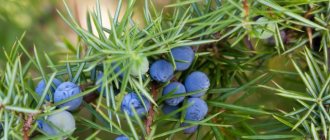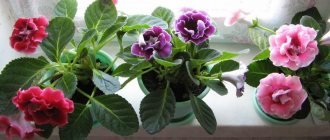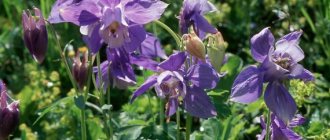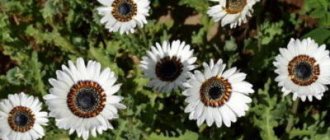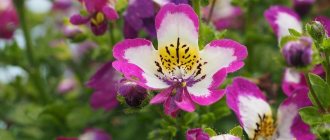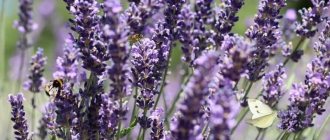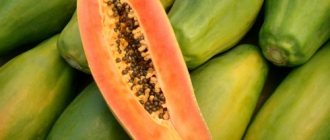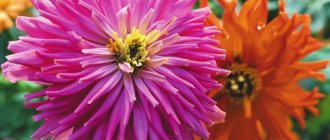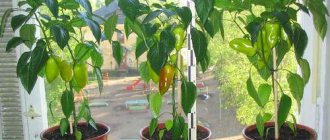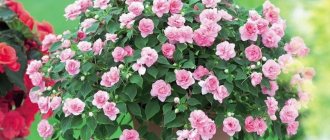Choosing a begonia variety
The begonia culture is characterized by attractive inflorescences and is divided into a large number of varieties and subspecies. When choosing a variety for propagation by seed, attention should be paid to the following:
- Deciduous begonia - rarely used for propagation by seed. Purchased at a specialized store and used for further germination.
- Tuberous varieties are most often used for seed propagation. A distinctive feature is the large buds. The plant can bloom for a long time.
- Bush begonia - can be propagated by various methods, including seeds.
Begonia propagation by seeds
Begonia grown from seeds does not lose its characteristics and quickly sprouts for further replanting in a permanent place.
The challenges and excitement of growing from seeds
There are several ways to propagate tuberous begonias: by seeds, leaf or stem cuttings, by dividing the tuber. Growing by seed is the most labor-intensive of them for the following reasons:
- Begonia seeds are very small; the germination rate and quality of store-bought seeds are sometimes disappointing, especially when there are only 5-10 of them in the purchased package. Good germination is ensured by fresh planting material, especially collected from your own plants.
- The seedlings are not friendly, they are also very small and delicate, and are demanding of conditions.
- Seedlings require long-term care, about 4 months, since at first they develop very slowly.
Nevertheless, planting tuberous begonias from seeds and caring for the seedlings is a fascinating process, keeping in mind the result. The reasons why amateurs go to such labor costs:
- The variety of varieties available commercially in seed form is much greater than in tuber form. It is easier to purchase seeds of new varieties of begonias than cuttings or tubers.
- Seeds are much cheaper than tubers and are more preferable the more plants you plan to get.
- With artificial pollination, you can get your own seeds, which produce plants with new qualities.
When growing from your own seeds, you can get the required number of plants of one variety, which will allow you to realize any design idea.
An example of using one variety of begonias in design
Begonia sowing time
Coral begonia flower at home
Begonia from seeds at home requires adherence to planting deadlines. Depending on the type of seed, the timing may vary. If seeds are purchased from a specialized store, they are planted a little later, since the planting material has already undergone preliminary preparation. If homemade seeds are used, begonias are planted in mid-January.
Selecting seeds for planting in the ground
Important! To facilitate the sowing process, the seeds are mixed with fine sand and evenly distributed over the soil surface.
Description of the plant and popular varieties
Begonia is a low growing shrub or herbaceous plant with beautiful bright flowers. The leaves and stems differ in shape and color depending on the type of flower. The following types of begonia are most often grown at home:
Ampelous - it has cascading shoots up to 45 cm long. Flowers are formed after 5-6 leaf nodes in the leaf axils. Each flower lives up to 10 days, and after falling, a new one appears in its place. Thanks to this, the plant seems to bloom continuously until late autumn. The most popular variety of hanging begonia is considered to be Chanson; it has beautiful white or yellow lush flowers.
Tuberous - has a tuberous rhizome and a tall fleshy stem, which reaches a height of about 80 cm. There are varieties with simple and double flowers that resemble roses, camellias, carnations or peonies. Flowers can be small, up to 3 cm in diameter, or large, up to 20 cm in diameter. They can be located singly or in inflorescences. The most popular varieties of tuberous begonia are Duck Red, Picoti Harlequin, and Bouton de Rose.
Ever-blooming is a complex hybrid that combines all varietal qualities. It is a low-growing shrub with fleshy stems and smooth, heart-shaped leaves. Flowers can be painted white, pink and red, collected in various inflorescences. Among the ever-blooming begonias are terry varieties, the flowers of which have a huge number of petals. They resemble small roses. In total, there are about 600 varieties of ever-flowering begonia, among which the most commonly grown at home are Ray, Queen, and Cocktail.
Bolivianum is a tuberous plant with long drooping stems that grow up to 80 cm and hang down in several tiers. The flowers are formed in several pieces on short peduncles and have a bright orange color. This type of begonia is suitable for growing in pots and containers, as it grows well in a small amount of soil. The most common varieties of this species can be called Santa Cruz, Bonaparte, Belavista.
When does a flower sprout appear?
Begonia elatior flower - home care
Ever-blooming begonia, the seedlings of which appear within 15 days after planting, requires careful care. After emergence, small sprouts reduce their growth rate and freeze for a while. It is important to ensure that the thin shoots are not damaged during watering.
Begonia sprouts after planting
Planting care
The shell can delay the emergence of seedlings for several days. Seed germination will have to wait from 10 to 25 days. All this time, as well as after the emergence of seedlings, certain agrotechnical rules must be observed.
- Do not remove the cover until the real leaves appear, just open it slightly every day for watering and ventilation.
- Watering should be done using a spray bottle or directly into the tray if the container with crops or peat tablets are in the tray. At the same time, waterlogging of the soil is unacceptable.
- Crops must be illuminated until the end of March, providing up to 14 hours of daylight, and should be protected from direct sunlight.
At first, the seedlings grow very slowly.
Picking seedlings
Picking of tuberous begonia is carried out 2-3 times.
After the appearance of three true leaves, the first picking is made, that is, planting in separate cups or simply at a distance of 5–6 cm from each other. In order not to damage the still very delicate roots of the plants, the soil must first be moistened so that it does not stick too much to the roots, but also does not fall off them completely. Plants should be scooped under the root and, together with a lump of earth, moved to a new place. After transplanting, be sure to water the young plants.
This is what begonia seedlings look like before the first picking
For plants in peat tablets, picking is not necessary; simply remove the shell from the tablet and transplant the seedlings into a larger container. After the first transplant, the seedlings develop more actively.
And here is the result of the first pick
When the leaves of neighboring plants close together, it’s time for the second pick. This time, each plant should be placed in a separate pot, in which it will remain until planted in a permanent place. The soil should have the same recipe as before.
It is necessary to have drainage and loosening elements (sand, vermiculite).
It’s high time for a second pick here
It is recommended to grow seedlings in a bright, ventilated place, gradually accustoming the plant to open ground conditions. Activities that need to be carried out regularly:
- moisten and loosen the soil;
- change the position of plants relative to the light source so that they are symmetrical;
- inspect plants in order to promptly notice development problems, the possible appearance of diseases or pests.
Top dressing
You should start feeding begonia a week after picking, using complex fertilizers intended for houseplants. Feeding should be done twice a month. If the plant does not develop quickly enough, you can additionally apply nitrogen fertilizer to increase the green mass, but the concentration of the fertilizer should be low.
When buds appear, it is preferable to use potassium-phosphorus fertilizers. Fertilizers are always applied to moist soil after watering.
Selecting a container for sowing
Begonia evergreen plant at home and in the garden
Begonia everflowering is a popular plant, growing from seeds at home requires a properly selected pot. Small containers are used for planting. Subsequently, the plant is transplanted to a permanent place. The following can be used as a container for planting seed:
- container for growing seedlings;
- silicone molds;
- special peat tablets;
- shallow trays.
Selection of capacity
Note! The pot should be wide, but not deep. This will speed up the germination process and make caring for the plant easier.
Algorithm for propagating begonia from seeds at home
Propagating a flower using seeds is a rather complex and painstaking process that requires compliance with many basic agricultural technology recommendations. You can get acquainted with all the nuances of such reproduction using a detailed algorithm of actions and step-by-step photos.
Sowing time
The appearance of the future plant and its flowering period depend on the time of sowing. Flower growers recommend starting sowing in January in order to admire the lush flowering of the plant at the beginning of summer.
Note!
With early sowing, by the time it is transplanted into an open pot, the begonia will have time to outgrow, which will significantly worsen the survival rate of the seedlings in the new soil and will significantly affect the general condition of the flower.
If sowed in late February or early March, maintaining optimal conditions will be much easier. During this period, solar activity increases significantly, and daylight hours last much longer. However, with such sowing dates, you should not expect flowering before July.
You may be interested in:
Lobularia: growing from seeds at home Lubularia is a flower with which you can create beautiful landscapes. It’s not difficult to care for, even…Read more…
Sowing in peat tablets
Carrying out the process of planting flower seeds is quite difficult, especially if untreated planting material was chosen. Ordinary seeds are practically unsuitable for spot sowing, so they are not planted in peat tablets. This is explained by the fact that the small size of unprocessed seeds will not allow them to be placed individually on the surface of the tablet. When sowing seeds in tablets, there is no need for further picking of seedlings.
Stages of sowing treated seeds in peat tablets:
- Place the tablets in water.
Peat tablets
- Wait until the tablets are well saturated with water.
- Place one seed on the surface of each tablet using a skewer or toothpick.
- When sowing the material, it is very important not to allow it to be deeply immersed, since the seeds need a large amount of light for active rooting.
Sowing seeds
- Lightly moisten the seeds with water.
Hydration
- Cover the seed tablets with a glass jar or plastic lid.
Tablets in a container
- Place the container with the seedlings in a warm place.
- It is better to water the seedlings through a tray, since this method of moisture intake will not allow the tablets to dry out.
It should be remembered that, due to the nutrient shell, pelleted seeds sprout a little later than usual. If all recommendations are followed, the first shoots may appear after 14 days. After their appearance, there is no need to keep plants in greenhouse conditions.
Sowing in the ground
It is better to sow the usual type of seeds directly into the ground, since their size makes them unsuitable for spot placement in peat tablets. However, before sowing such seeds, they must be mixed with sand for a more even distribution over the surface of the earth. (Seed pellets can also be sown directly into the ground.)
Begonia sprouts
When planting seeds in the soil, it is recommended to adhere to the following sequence:
- Moisten the previously prepared soil mixture.
- Spread the seeds over the surface of the soil without submerging them.
- Lightly spray the seedlings with water.
- Cover the container with the seedlings with plastic wrap or glass.
- Move the container to a warm place.
It is better to moisten tender begonia seedlings using a spray bottle. If all agricultural technology conditions are met, the seeds will sprout within 10-12 days after sowing. After the first shoots appear, the glass is removed and the container with seedlings is placed in a well-lit place. After several leaves appear on the young shoots, they need to be planted in separate pots.
Soil preparation
Growing tuberous begonia at home from seeds requires preliminary soil preparation. Soil for planting can be purchased at a specialized store or prepared independently. To make your own nutritional mixture you need:
- mix part of the leaf soil and half of the peat and sand;
- sift the resulting mixture so that there are no lumps and fill the container.
Additional Information! Begonia seeds are small, so they are not planted too deep, otherwise the sprouts will take a very long time to appear.
Preparation of planting material for growing begonias
One of the main stages of growing begonia at home is the correct selection and preparation of seeds for planting.
Choosing a begonia variety
All varieties of the plant were united by breeders into three large varietal groups; they distinguish between deciduous, bush and tuberous begonias. Separation according to characteristics makes the choice easier for gardeners and helps provide the plant with proper care.
Deciduous varieties are not very suitable for growing using seeds due to the difficulty of obtaining planting material at home. However, if you want to grow deciduous begonia from seeds, planting material can be purchased at a specialty store.
Decorative deciduous begonias
Representatives of tuberous varieties differ from their relatives in their large flowers and long flowering, therefore they are excellent for seed propagation. Despite this, tuberous begonia is most often propagated by dividing the tuber and cuttings.
Begonia tuberous
Among the representatives of bush begonias you can find ever-flowering specimens that are convenient to grow from seeds. Bush begonias, unlike other varietal groups, are most often propagated by this method.
Rules and timing of seed collection
The time for collecting material for planting directly depends on the type of flower and its flowering period. For this reason, it is worth focusing on the condition of the plant’s seed pods: yellowing and drying indicates that it is time to start collecting planting material. The main thing is to prevent them from overripening, otherwise they will begin to burst and all their contents will simply spill out.
To conveniently collect the material, you need to remove the dried boxes and place them on paper. After one or two weeks, they will finally dry out and burst, and their contents will end up on a sheet of paper.
Collecting seeds
It is recommended to store the collected material in a paper bag placed in a cool and dry place.
Choice when purchasing
When buying seeds, you should pay attention to the time of their collection, since fresh planting material sprouts much earlier. When properly stored, planting material has a shelf life of 5 years.
On sale you can find regular and granular seeds, the latter are covered with a nutritious shell, which acts as a protective layer and significantly increases their size.
Granulated seeds
Flower growers recommend choosing granulated seeds for several reasons:
- Planting such material is much easier due to its larger size.
- Flowers grown from such seeds are more resistant to various diseases and pests.
- Seeds in granules are planted in a peat tablet, thereby eliminating the need for further digging.
- Begonias that sprouted from seeds coated with a nutrient shell bloom much better.
It is quite difficult to plant ordinary seeds, since their microscopic size does not allow the material to be distributed evenly throughout the soil.
Necessary equipment for germination
Preparing the necessary equipment plays an important role in the process of growing begonias. To plant seeds in granules you need to prepare:
- tray with water;
- peat tablets;
- spray bottle with water;
- glass or plastic jar.
Material for planting seeds
To distribute microscopic seeds evenly throughout the soil, they are mixed with sand. When germinating raw material, the list of necessary equipment changes slightly. You will need:
- Container for seedlings.
- Glass for covering seedlings.
- Spray bottle for watering.
You may be interested in:
Petunia: when to plant and how to grow? You can grow petunias yourself or purchase ready-made flowers. However, many gardeners will choose the first...Read more...
Substrate preparation
Begonia must be grown in loose, nutritious soil with a slightly acidic or neutral reaction. It is worth understanding that the nutrition of the plant and its growth rate depend on the choice of substrate. Suitable soil for begonias can be purchased at a specialty store or prepared independently from leaf soil, peat and sand in a 2:2:1 ratio. Coconut fiber or vermiculite will help make the prepared soil loose.
The finished mixture should be passed through a sieve to remove large particles. You should also understand that when collecting leafy soil on the street, you may come across soil contaminated with various microorganisms that can harm the plant. To avoid negative consequences, it is recommended to disinfect such soil by dousing it with boiling water. When sowing granular seeds, the soil mixture can be replaced with peat tablets with a retaining mesh.
Sowing seeds
In order to get quick shoots, it is important to observe the specifics during sowing. Seeds must be planted in the ground at a shallow depth. The top of the seed should not be covered with soil, as this may lead to the death of the seed. The following step-by-step instructions are provided for planting:
- Fill the planting container with a nutrient mixture;
- water the soil thoroughly and leave for a few minutes so that all the water is absorbed;
- carefully plant the seeds in small holes;
- Cover the top with film or glass.
Using film allows you to create a greenhouse effect and speed up seed germination. If seeds are germinated in the summer, you should regularly remove the film and let in fresh air so that the seeds do not suffocate.
It is important to know! The seeds should be sown in an even layer. This will increase the number of seedlings. After the sprouts appear, you need to carefully thin them out, leaving the strongest specimens.
Sowing in peat tablets
In order for the plant to germinate quickly, it is recommended to use special pressed peat tablets. Perform the following algorithm of actions:
- the tablets are placed in a container that does not allow moisture to pass through;
- hot water is poured into the container so that the compressed peat begins to gradually swell;
- monitor the condition of the tablet, add water if necessary;
- the seed is placed in the center of the swollen peat;
- After the seeds are planted, the container should be covered with film and placed in a sunny place.
Using peat tablets to grow begonias
In order to speed up the germination process, it is necessary to carefully monitor the condition of the nutrient mixture and regularly moisten it.
Seed selection
To grow beautiful and healthy plants, you need to choose high-quality seed material. When choosing them, you should consider the following:
- Packaging time. It is recommended to choose fresh seeds that were collected this year. The longer the seeds are, the less similar they will be, even if the expiration date indicated on the package has not yet expired.
- It is more convenient to plant granulated seeds in peat tablets. They have a dense coating of nutrients that make the seeds larger.
- It is more convenient to sow simple seeds in containers or seedling boxes.
What affects germination?
In some cases, the seed does not germinate well, and gardeners cannot wait for the sprouts to sprout. The following factors can affect seed germination:
- Improper storage of planting material. In a cold and wet place, sprouts may not appear.
- Insufficient moisture. If there is no regular watering, the soil will dry out and sprouts will not appear.
- Incorrect temperature. In order for the seeds to sprout, you need to place the container with the sprout on the windowsill. The temperature for germination should be at least +25 ℃.
You should know! A long period of storage of seed material can affect the growth of sprouts. Seeds can be used for planting for three years.
How to choose seeds
There are two types of seeds: regular and granulated (also called coated). Regular untreated ones look like dust. 1 g of such dust contains 60,000 seeds - it is difficult to distribute them evenly over the ground. Granular ones are another matter; they are coated with a nutrient solution, due to which the seeds become large, and it is more convenient to sow them in peat tablets.
Important! The seeds must be “fresh”: experienced gardeners say that their germination rate decreases every year. Therefore, it is worth buying only seeds of the current year, even if the packaging indicates that they will remain viable for 3-4 years.
Below in the photo are begonia seeds in granules.
Transplantation to a permanent place
Tuberous begonia is grown from seeds, planting and caring for planting material is no different from other varieties. After the plant germinates, it is transplanted to a permanent place of growth. Before planting, you should choose the right pot. The container should be medium in size. The roots of the plant have an average degree of development. The root shoots should not be too constrained by the walls of the pot. The steps for transplanting a plant to a permanent place of growth are as follows:
- Small pebbles must be placed in the prepared container as drainage.
- Mix the leaf mixture, peat, sand and humus in equal proportions. The resulting nutrient mixture fits tightly into the pot.
- Moisten the soil thoroughly.
- Make a small hole in the soil.
- Remove the seedlings along with the soil and place them in a new place.
- Compact the soil.
Transplanting seedlings to a permanent place of growth
If peat cups are used, begonia can be planted in a pot together with a peat container. Subsequently, the peat cup will fall into pieces.
Important! It is not recommended to use deciduous soil in areas where oak or willow grows. Such soil may contain tannins that negatively affect plant growth.
Caring for young plants and replanting at home
Caring for young begonias is quite simple; it is enough to ensure regular watering and a comfortable temperature:
- Full care of shoots includes a hardening procedure. The process involves periodically airing the sprouted seeds: it is enough to remove the polyethylene or glass from the container for 10-15 minutes from the moment the first leaf germinates until picking. With the help of hardening, the young plant gets used to the environment and gets rid of excess moisture.
- For active growth of young begonia, it must be kept in conditions of good lighting, but without overheating under direct rays. The optimal temperature for keeping young begonia is 20-22 °C.
Begonia care
- Young shoots of begonia are very tender, even water can damage them, so watering must be done using a spray bottle. It is recommended to use soft warm water for watering.
A plant grown in the ground should be replanted in 2 stages with an interval of 30 days. The root system of begonia is quite easy to damage, so replanting it should be done with extreme caution. The first picking of the plant should occur only after at least 2 leaves appear on the shoots. A week before planting a flower in a permanent container, it is recommended to add a complex fertilizer with a low nitrogen content to its soil.
Advice!
As a top dressing, you can use a solution of potassium phosphate.
Stages of transplanting a plant into a permanent container:
- Place a layer of drainage on the bottom of the pot.
- Pour the soil mixture of leaf soil, peat, sand and humus into a container with a diameter of 6-8 cm.
- Carefully place the plant in the soil and fill the empty spaces of the container with soil.
- Moisten the soil.
The flower will grow in this soil throughout the next year, so do not forget to feed the young plant with complex fertilizers for ornamental crops every 2 weeks.
You may be interested in:
Growing Chinese double carnation from seeds Carnations on the plot are simple flowers, but they can easily decorate any flower bed. It is recommended to grow terry carnations...Read more...
Basic rules of watering
When growing begonias, it is important to follow the watering rules. Peculiarities:
- after planting, watering must be carried out by spraying with a spray bottle;
- It is not recommended to spray sprouts, as this can lead to burns and yellow spots;
- The plant must be watered once every three days;
- in summer, the pot with the plant is placed in a pan of water; The roots will absorb the required amount of liquid on their own.
Before use, the water is pre-settled and only then used for irrigation.
Begonia is grown using a variety of methods. Seed allows you to get a large number of seedlings without reducing characteristics. It is important to choose the right planting material and follow all the rules for planting in the ground.
Diseases and pests
By following all the rules for growing begonia from seeds, you can significantly reduce the risk of seedling disease. However, you need to be aware of possible problems in order to see them in time and take the necessary measures. When growing begonia from seeds, the following diseases and pests may appear:
- Root rot, to get rid of this problem it is necessary to ventilate the greenhouse more often and reduce watering.
- Powdery mildew.
- Aphids and spider mites are controlled with insecticides and fungicides.
How to plant begonia with seeds? Detailed instructions with photos
So, to grow begonia from seeds (tuberous and ever-flowering), you need to buy fresh seed. The grains must be collected this year. Next, you need to organize a greenhouse and select soil. Food containers with transparent (non-colored) walls and a lid are often used as greenhouses. This guarantees good illumination of the seedlings. You can take a special container for seedlings. After sowing, it is covered with glass or plastic film.
I sowed begonia seeds in a regular food tray with transparent walls, and also used transparent plastic water bottles, having previously trimmed them. The resulting design is shown in the photo below. Such a greenhouse is compact and costs absolutely nothing.
Soil for growing begonias from seeds. You can buy special soil. This is Begonia land, where pH = 5.5-6.5. Some gardeners like peat tablets. Before planting the seeds, simply fill the peat tablets with warm water and wait until they swell. If you pour boiling water over peat tablets, you need to wait a little. Peat tablets should not only swell well, but also cool down. Advantages of peat tablets: the plant that grows in them does not need to be planted. When the roots of the plant completely entwine the peat tablet, the latter can simply be transferred to a pot with soil. That is, picking in its full sense is not carried out; the roots of the plant do not experience stress.
I don't like peat tablets. Why? It is difficult to control their humidity. Peat holds moisture well. While the surface of the peat tablet has dried, the inside remains moist. If you miss this moment and regulate watering based on the moisture level of the peat surface, you can flood the plant. And some plants react very painfully to waterlogging. If begonias can be over-watered a couple of times, then, for example, gerberas are very sensitive to overwatering and immediately begin to turn yellow.
So, based on my purely practical experience, I plant begonia seeds in universal soil (it is easier to find in stores compared to specialized soil mixtures) with the addition of coconut fiber. I do not add sifted sand to the soil, since coconut fiber increases the moisture and breathability of the soil. I don’t add vermiculite either (it is found in small quantities in universal soil and that’s enough). Even though the mixture consisting of universal soil and coconut fiber dries out faster compared to soil + vermiculite, I am sure that my seedlings will not rot. And the greenhouse helps maintain soil moisture at a constant level.
Planting proceeds as follows : drainage holes must be made in the container. Fine expanded clay is placed on the bottom. Next, the prepared soil is poured. It is leveled and watered with a spray bottle. The soil should be moist, but not very wet.
Next, the begonia seeds (as shown in the photo above) are laid out on the surface of the soil at a distance of 1 cm from each other . The grains are very small, similar to dust, and therefore a toothpick or needle will come in handy here. Once again, carefully water the soil with a spray bottle. You don’t need to be too zealous with the water pressure, otherwise the small seeds will simply be washed away. The seeds do not need to be pressed into the ground or sprinkled with soil on top. This negatively affects germination.
After watering, the greenhouse is closed and placed in a bright place for germination. The recommended germination temperature is +20…+24 degrees. But I came to the conclusion that the germination temperature simply should not fall below +17 degrees. It is imperative to organize illumination 12 hours a day if there is not enough natural light. This could be a fluorescent lamp. It is preferable to place greenhouses on windows on the east or west side. How to water? Usually, high air humidity is maintained in the greenhouse, but sometimes the soil needs to be watered with warm water. Bottom watering is not recommended. I water either with a syringe (a drop of water under each plant) or with a spray bottle. But you need to be careful with the water pressure, otherwise the seeds are easily washed away from the surface of the soil.
If condensation forms on a greenhouse with begonia seeds, this indicates high humidity of both the air and the soil inside. To fix everything, increase the ventilation time of the greenhouse (2 times a day for 20 minutes). No watering is carried out.
Types of begonia
There are 3 main types of begonia:
- decorative deciduous (Royal);
- bush (Coral);
- tuberous (ever-blooming).
Among the most popular varieties of tuberous (ever-blooming) begonia are the following: Camellia, Marmorata, Samba, Alcor, Pikoti, Ampelnaya.
As a rule, only tuberous begonia is grown in the open ground in the garden; other varieties (deciduous and bush) are grown at home or indoors.
How to plant?
Despite the laboriousness of planting seeds, this propagation method allows you to obtain strong, healthy and beautiful plants. But for this you need to take into account several important points.
The right time
In order for begonia to bloom in May, the seeds must be planted in late December - early January. But for such early plants, additional lighting will be required. Lack of light will make begonias sickly and frail.
Flower growers believe that the optimal period for planting seeds is mid-February. In this case, the plants do not need additional light sources. But they will delight you with their flowering no earlier than June-July.
Choosing a pot
Before you start planting seeds, you need to choose the “right” container for future plants. Begonia grows comfortably in compact and shallow pots. The following containers are suitable for planting:
- containers for growing seedlings;
- muffin tins;
- trays with low sides;
- shallow boxes.
Soil preparation
Begonia prefers neutral or slightly acidic soil. The soil can be purchased at the store or prepared yourself.
Substrate manufacturing algorithm:
- Sand (1 part), peat (1 part) and leaf soil (2 parts) are thoroughly mixed.
- To get rid of lumps, the resulting soil is sifted through a sieve.
- Then the soil is disinfected by frying the mixture in the oven.
Instead of an earthen substrate, you can use peat tablets. They do not require any preparation.
If the choice fell on peat tablets, then in the future there will be a need to constantly monitor the level of soil moisture. This soil dries out very quickly. If you do not moisten it in a timely manner, the sprouts may die.
Sowing
The landing algorithm includes the following steps:
The prepared soil is poured into the selected container.
- The soil is moistened.
- Seeds are sown on the surface of the soil. For convenience, you can use a sheet of paper. It is folded in half and the seeds are poured inside. Lightly tapping this design with a needle will ensure minimal seed loss.
- Planting material is not covered on top.
- The planted seeds are moistened with a spray bottle.
- The containers are covered with glass or film that transmits light.
Reference. When planting, you can use snow. It is laid out on the ground. Begonia seeds are sown from above, directly on the snow. The snowball will gradually melt, providing additional moisture and uniform distribution of the seed.
If peat tablets are used, the seed planting algorithm consists of the following steps:
- The tablets are placed in the selected container. In this case, it is best to use containers for seedlings. 1 tablet is placed into each cell.
- Peat soil is thoroughly moistened.
- Place one seed on top of the softened tablet.
- Using a spray bottle, water the crops.
- The container is covered with a transparent film.
How to care for begonia seedlings?
Begonia seedlings are very small, since the seeds are not large in size. They can often only be seen under a magnifying glass. First, thin threads of roots appear from the grains. The main thing during this period is not to turn the grains over. Next, the cotyledons appear. During this period, some gardeners advise reducing the temperature of the seedlings to +18 degrees. However, the majority is of the opinion that the conditions cannot be changed, that is, the temperature should remain within +21...+24 degrees, 12-hour daylight hours and high humidity. We ventilate the greenhouse 2 times a day. It is better to water the seedlings in the morning. A syringe is used for this. I completely agree with everything, but regarding the temperature I have my own opinion. I repeat once again: the temperature of begonia seedlings should not fall below +17 degrees. The lower the temperature, the less watering.
For the first 1-1.5 months, begonia from seeds grows very slowly. It may seem to many that the seedlings are not growing at all. This is an incorrect statement. During the first months of its life, a small plant grows a root mass (in the case of ever-flowering varieties) or a tuber (tuberous varieties). During this period, you can feed the seedlings. To do this, take fertilizer for foliage and ornamental plants and dilute it 3 times more than indicated in the instructions. Fertilizer should be applied drop by drop near each shoot only into wet soil. Illumination is required, otherwise the seedlings will stretch out.
As soon as the seedlings grow roots, they produce their first pair of true leaves. At this time, I begin to accustom the begonia seedlings to room humidity. I increase the ventilation time of the greenhouse. I pick at the stage of the first pair of true leaves.
Picking is carried out in containers of 30-50 ml. Regular plastic cups with drainage holes or special containers that can be easily purchased in a store are suitable for this. You either buy special soil for begonias, or use universal soil for flowering indoor plants. In practice, I tried a mixture of universal soil + coconut fiber. Very pleased with this mixture.
Next, I grew my begonias from seeds at room temperature +18...+25 degrees. After picking, I placed the plants on the east side of the house. Watering as the soil dries, feeding with fertilizer for flowering plants with microelements. The second picking was carried out as soon as the small begonia entwined its roots around the soil in the cup.
For successful growth and flowering, begonias need bright, but diffused light. Begonias practically do not bloom in the shade; their leaves burn from direct rays. The soil between waterings should dry out to half the pot, more is possible. Constantly wet soil in tuberous begonia causes the tuber to rot and the shoots to rot. The plant responds very well to feeding. The transplant can be done after the winter dormant period, when the tuber wakes up.
How to get seeds?
Like many plants, after flowering, begonia forms seed pods filled with tiny dusty specks. Typically, gardeners remove them along with the dried stems, but if desired, this material can be collected and used for sowing over the next 3-5 years.
blobid1547301999204-1.jpg
Ever-blooming indoor species rarely set seeds on their own. The reason is that begonias have male and female flowers. The first ones are larger and more magnificent, the second ones are small and inconspicuous. To form an ovary, pollen from the “male” specimens must fall on the pistils of the “female” ones. On the street, insects and the wind cope with this task, but at home, the flowers will have to be pollinated by hand, using a thin, dry brush or a cotton swab. Some hybrid varieties, often double ones, are deprived of the possibility of seed propagation, since all the stamens in them are initially converted into additional petals.
835f20dc6a900d3f44e18d513531f8fd_i-215.jpg
The seeds should be collected after the capsules have completely dried, otherwise they will not have time to ripen. It is best to store seed in a dry, dark place, in a paper bag or small cardboard container. This is necessary for free air circulation, without which the embryos may lose germination.
